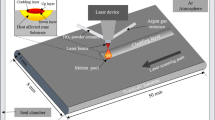Abstract
Based on the three-phase model, the propagation behavior of a matrix crack in an intelligent coating system is investigated by an energy criterion. The effect of the elastic mismatch parameters and the thickness of the interface layer on the ratio of the energy release rate for infinitesimal deflected and penetrated crack is evaluated with the finite element method. The results show that the ratio of the energy release rates strongly depends on the elastic mismatch α 1 between the substrate and the driving layer. It also strongly depends on the elastic mismatch α 2 between the driving layer and the sensing layer for a thinner driving layer when a primary crack reaches an interface between the substrate and the driving layer. Moreover, with the increase in the thickness of the driving layer, the dependence on α 2 gradually decreases. The experimental observation on aluminum alloys monitored with intelligent coating shows that the established model can better explain the behavior of matrix crack penetration and can be used in optimization design of intelligent coating.
Similar content being viewed by others
References
Miller, C. A. and Hinders, M. K. Classification of flaw severity using pattern recognition for guided wave-based structural health monitoring. Ultrasonics, 54(1), 247–258 (2014)
Costiner, S., Winston, H. A., Gurvich, M. R., Ghoshal, A., Welsh, G. S., Butler, S. L., Urban, M. R., and Bordick, N. A probabilistic hybrid sensor fusion and optimization approach for aircraft composite components. Journal of Intelligent Material Systems and Structures, 24(17), 2110–2134 (2013)
Zhang, B. N., Wang, S. L., Li, X. X., Zhang, X., Yang, G., and Qiu, M. F. Crack width monitoring of concrete structures based on smart film. Smart Materials and Structures, 23(4), 1–15 (2014)
Keenahan, J., OBrien, E. J., McGetrick, P. J., and Gonzalez, A. The use of a dynamic truck-trailer drive-by system to monitor bridge damping. Structural Health Monitoring, 13(2), 143–157 (2014)
Yang, J., Lee, H., Lim, H. J., Kim, N., Yeo, H., and Sohn, H. Development of a fiber-guided laser ultrasonic system resilient to high temperature and gamma radiation for nuclear power plant pipe monitoring. Measurement Science and Technology, 24(8), 085003 (2013)
Lee, H., Yang, J., and Sohn, H. Baseline-free pipeline monitoring using optical fiber-guided laser ultrasonics. Structural Health Monitoring, 11(6), 684–695 (2012)
Liu, M. B., Wang, X. H., Liu, Q. D., and Gao, H. Application of smart coating sensor in crack detection for aircraft. International Conference on Mechanical Engineering and Materials, Trans Tech Publications Ltd., Stafa-Zurich (2012)
Hu, F., Liu, M. B., and Lv, Z. G. The flaw-detected coating and its applications in R&M of aircrafts. 2nd International Conference on Smart Materials and Nanotechnology in Engineering, SPIE-INT Soc Optical Engineering, Bellingham (2009)
Liu, M. B., Sun, Y., Wang, Z., and Wang, X. B. A validation study for a SHM technology under operational environment. 60th Annual Reliability and Maintainability Symposium, IEEE, New York (2014)
Cook, J. and Gordon, J. E. A mechanism for the control of crack propagation in all-brittle systems. Proceedings of the Royal Society of London A, 282(1391), 508–520 (2004)
Gupta, V., Argon, A. S., and Suo, Z. Crack deflection at an interface between two orthotropic media. Journal of Applied Mechanics, 59(2S), S79-S87 (1992)
He, M. Y. and Hutchinson, J. W. Crack deflection at an interface between dissimilar elastic materials. International Journal of Solids and Structures, 25(9), 1053–1067 (1989)
He, M. Y., Evans, A. G., and Hutchinson, J.W. Crack deflection at an interface between dissimilar elastic materials: role of residual stresses. International Journal of Solids and Structure, 31(24), 3443–3455 (1994)
Ahn, B. K., Curtin, W. A., Parthasarathy, T. A., and Dutton, R. E. Criteria for crack deflection/penetration for fiber-reinforced ceramic matrix composites. Composites Science and Technology, 58(11), 1775–1784 (1998)
Liu, Y. F., Tanaka, Y., and Masuda, C. Debonding mechanisms in the presence of an interphase in composites. Acta Materialia, 46(15), 5237–5247 (1998)
Lee, W., Yoo, Y. H., and Shin, H. Reconsideration of crack deflection at planar interfaces in layered systems. Composites Science and Technology, 64(15), 2415–2423 (2004)
Jia, H. K., Wang, S. B., Li, L. A., Wang, Z. Y., and Goudeau, P. Application of optical 3D measurement on thin film buckling to estimate interfacial toughness. Optics and Lasers in Engineering, 54, 263–268 (2014)
Wang, W. X., Gu, Y. Z., Li, M., Liu, H. X., and Zhang, Z. G. Characterization of interfacial bonding property of carbon fiber/epoxy resin using single fiber fragmentation test with dual matrix composites. Acta Materiae Compositae Sinica, 30(4), 1–6 (2013)
Wang, Z. Y. and Wang, A. W. Experimental study of fracture toughness of rubber-steel bond interface. Chinese Journal of Solid Mechanics, 31, 204–208 (2010)
Godara, A., Gorbatikh, L., Kalinka, G., Warrier, A., Rochez, O., Mezzo, L., Luizi, F., van Vuure, A. W., Lomov, S. V., and Verpoest, I. Interfacial shear strength of a glass fiber/epoxy bonding in composites modified with carbon nanotubes. Composites Science and Technology, 70(9), 1346–1352 (2010)
Swentek, I. and Wood, J. T. Measuring polymer composite interfacial strength. Composites Part B: Engineering, 58, 235–241 (2014)
Dundurs, J. and Bogy, D. B. Edge-bonded dissimilar orthogonal elastic wedges under normal and shear loading. Journal of Applied Mechanics, 36(3), 650–652 (1969)
Kim, J. B., Shin, H., Lee, H., and Rhee, K. Y. Effect of virtual crack size on the crack deflection criterion at a bi-material interface under wedge loading. Mechanics Research Communications, 36(2), 193–198 (2009)
Hu, F. Intelligent Coating and Its Application in Aircraft Structural Health Monitoring (in Chinese), M. Sc. dissertation, Xi’an Jiaotong University (2007)
Author information
Authors and Affiliations
Corresponding author
Additional information
Project supported by the National Natural Science Foundation of China (No. 51175404)
Rights and permissions
About this article
Cite this article
Sun, Y., Wang, W., Li, B. et al. Investigation on behavior of crack penetration/deflection at interfaces in intelligent coating system. Appl. Math. Mech.-Engl. Ed. 36, 465–474 (2015). https://doi.org/10.1007/s10483-015-1921-9
Received:
Revised:
Published:
Issue Date:
DOI: https://doi.org/10.1007/s10483-015-1921-9




